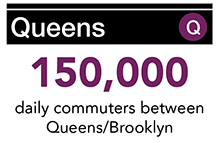When Transit Wireless and the MTA announced expanded cell service at 30 additional stations in late April, the press conference included word that the two remaining major carriers — Sprint and Verizon Wireless — would soon be on board. Sprint wrapped its deal a month ago, and today, Transit Wireless announced that Verizon has come to terms too.
“We are extremely pleased to gain Verizon’s participation in our wireless network in the New York City subway system, facilitating high quality voice and data services in the underground,” William A. Bayne Jr., CEO of Transit Wireless, said in a statement. “We have now secured partnerships with all four major wireless carriers to bring the vast majority of New Yorkers, visitors, government agency personnel, transit employees, contractors and first responders the ability to be connected in the stations we’ve constructed – a real milestone.”
The carrier will bring its 3G and 4G LTE voice and data services to Transit Wireless’ in-station network in the subway system. Verizon will begin installation of their equipment soon, and Verizon Wireless customers — like me! — should see service in the 36 stations currently online later this year. The 40 Phase 2 stations set for early-2014 activation will include Verizon services. Welcome to the future.



 During Thursday night’s Public Advocate debate, three of the five candidates expressed their support for subway naming rights deals. I don’t know why the other two were so hesitant, but Tish James, Daniel Squadron and Sidique Wai all said they would support such deals. This is hardly a controversial position to take, but it’s one that requires a partner. New Yorkers can support naming rights until the cows come home, but if no one is buying them, what’s the point?
During Thursday night’s Public Advocate debate, three of the five candidates expressed their support for subway naming rights deals. I don’t know why the other two were so hesitant, but Tish James, Daniel Squadron and Sidique Wai all said they would support such deals. This is hardly a controversial position to take, but it’s one that requires a partner. New Yorkers can support naming rights until the cows come home, but if no one is buying them, what’s the point? For reasons of history, the New York City subway system is very good at bringing riders and commuters into and out of Midtown and Lower Manhattan. Before the subways were built out, that’s where people lived and worked and played, and after the subways were built, New Yorkers still wanted to get back to those roots. The jobs, entertainment and culture never left.
For reasons of history, the New York City subway system is very good at bringing riders and commuters into and out of Midtown and Lower Manhattan. Before the subways were built out, that’s where people lived and worked and played, and after the subways were built, New Yorkers still wanted to get back to those roots. The jobs, entertainment and culture never left.